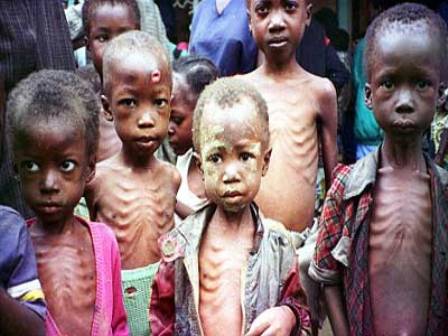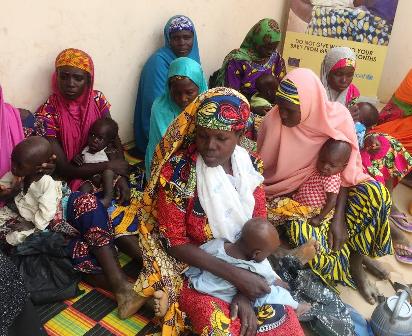As the nation turns its attention to the COVID 19 pandemic, bandits have continued their attack on villagers in Sokoto and Zamfara states, resulting in increased displacement of women and children. This situation has led to severe hunger and increased child malnutrition. Investigations by Franka Osakwe, reveal that the states have been hit by a malnutrition crisis, now killing children in the North West region of the country, far more than the COVID-19 pandemic.
A mother’s plight

One year after bandits drove Zuwaira Lawal and her family from their home in Kamitau, a village in Goronyo Local Government Area of Sokoto, she had to put up a fierce struggle to save her three-year-old malnourished baby from dying.
20 year old Zumaira could recall how her husband and 24 other villagers were massacred that day, by the bandits, “it was terrible! I could only escape with my three children, without any property. The bandits stole our lands and cows”, she narrated.
Now resettled at Illela – a safer community in the Local Government – without any means of livelihood, the mother of three said she could only survive and cater for her children by begging for alms.
“Sometimes people give us something, sometimes they don’t. Getting drinking water is also very difficult. We have to trek far distance to fetch water from borehole”’ she said.
Aside the bandit attacks, the lockdown due to COVID 19 pandemic has resulted in even more food scarcity, and increased prize of staple food.
“Now things are even worse. People are in their houses. Shops and mosques are closed”, she lamented.
When her last baby, Hassan became seriously ill, six months ago, vomiting and stooling constantly, she tried all she could to save him.
“I gave him herbs and drugs but he got worse. Then, he stopped eating completely”, she recalled.
Luckily, she heard about the free malnutrition treatment program taking place at the Sabon-Gari Dole Primary Health Care Centre, and made a last attempt to save her baby.
“Someone told me about the UNICEF program at Sabon-Gari Dole, so I brought my baby for treatment”, she said.
Two weeks after, Hassan has started regaining weight and is better.
Hassan is one of the many children currently receiving free treatment for severe acute malnutrition at Sabon-Gari Dole Primary Health Care Centre, Goronyo LGA, Sokoto State.
According to the CMAM Officer in charge at the ward, about 150 children have been treated successfully between October 2019 till date, at the Out-patient Treatment Centre (OTC).
How displacement of rural communities by bandits results in malnutrition crises
Conflict between herdsmen and farmers in Sokoto and Zamfara States, coupled with criminal banditry, resulted in the displacement of rural populations in 2018 and 2019, according to information from the state.
By Mid-2019, there were tens of thousands of internally displaced persons (IDPs) living in makeshift camps and amongst host communities in several affected Local Government Area (LGAs) of both Sokoto and Zamfara States. Most of these IDPs are women and children.
Many families with their children were rendered homeless, without food and source of income. Now, the recent COVID 19 pandemic is worsening the situation, investigation reveals.
Response by UNICEF
UNICEF with support from the European Civil Protection and Humanitarian Aid Operation (ECHO) of the European Union, in collaboration with the State Primary Health Care Developemnt Agencies of Sokoto and Zamfara, has set up Severe Acute Malnutrition treatment sites in 20 wards (7 in Sokoto and 13 in Zamfara).
These wards are in 7 LGAs; 3 in Sokoto (Rabah, Goronyo and Sabin Bini), and 4 in Zamfara (Shinkafi, Maradun, Zurmi and Birmingham Magaji) that are badly affected by the violence. All the 20 wards have a high number of IDPs and malnourished children from the IDPs as well as the host communities, currently benefiting from the intervention.
A health worker attends to a malnourished child
At Sabon-Gari Dole Primary Health Care Centre, one of the treatment wards, The Community Management of Acute Malnutrition (CMAM) person in Charge, Bashar Saidu, explains how Hassan and other children are saved everyday at the centre.
“When the baby comes here, we first measure his Mid-Upper Arm Circumference (MUAC). If it’s below 11.4CM, and the child weighs 4 kg and above, and has no medical condition then the child will be admitted into the program. For those with medical condition, we refer them to the In-patients Care Centre (IPC), where they will receive food and treatment. After treatment at the IPC, the child will be sent back to the Out Patient Treatment Centre (OTC).
“Each week when they come, we check their MUAC and weight to see if the MUAC and weight are increasing. If there is no progress after two consecutive visit, we refer them to the IPC. But we expect progress within one week”, he said.
At the centre, Zumaira and other caregivers, about 50 women with their malnourished children, were seated at the OTC, waiting their turn for the clinical assessment and the weekly RUTF ration.
So far, UNICEF Nutrition Head Sokoto, Walton Beckley, explains, about 4,565 and 5,755 children with severe acute malnutrition have been admitted for treatment in Sokoto and Zamfara states respectively.
According to him, the number of children with severe acute malnutrition successfully treated in Sokoto were 3,963 and 5,057 in Zamfara state.
“The number of pregnant women that received iron and folic acid supplements are 3,716 in Sokoto and 4,706 in Zamfara state. In Sokoto, about 5,688 pregnant women and caregivers of children less than two years have received advice on how to take care of their children and feed them to prevent malnutrition. In Zamfara State about 8, 219 women received same advice”, he explains.
While treatment at the Out-patient treatment Centre (OTC) and the RUTF procured by UNICEF are completely free, investigation however reveals that this is not the case at the IPC as treatment is not entirely free there.
Explaining the reasons for these, the CMAM person said:
“At the IPC here, there is no therapeutic milk such as F75 and F700 which is normally given to the patient that don’t eat the RUTF. So care givers are told to buy milk and give the child. A can of formula milk will cost about N3,000 or N4,000 Naira and the care giver is expected to buy the milk continuously until the child recovers. Aside purchasing the milk, the care giver at times buy some routine drugs while some are given free”
Lack of financial support from government slowing down effort to curb malnutrition
Despite the success of the CMAM program, investigation reveals that government has not shown enough commitment towards the program. For instance, it was gathered that the 2019 Sokoto State approved budget for nutrition has not been released till date.
If this is released, Mr. Beckley, said it could be channeled to nutrition programs like the CMAM.
“The state governments are our main partners. The facilities and staff are provided by government while we provide technical support with hope that government will eventually complete the program”.
According to him, setting up a stabilisation centre or In-patient Centre (IPC) is not as easy as OTC.
“We have been working with donors to ensure that we get the stabilisation centre working but only UNICEF is responding to the crises in Sokoto at the moment. We are trying our best to ensure that the children do not develop medical complication before being brought to the OTC”.
In order to make better progress and save more children, he said there is need for government and other humanitarian organisations to step in and help save the children.
“We also need other agencies such as World Health Organisation (WHO), to step in. From our screening results, We have huge number of children who are moderately malnourished but our program are not designed to address this. We are focused on children that are severely malnourished so we need other agencies that can address this such as World Food Program (WFP), to step in and assist.
“The RUTF is very expensive to procure and get across to the children that need it. One child will consume at least a carton of RUTF throughout the program. If this program funded by ECHO runs out, its continuation may be badly affected”.
On Why treatment is not free at the IPC, UNICEF State Nutrition Supervisor, Sokoto, Ijanada Aliyu Jacob, said;
“Normally we work with the state government and because we want the state government to take ownership of the activity, we allow the government to give their own support in purchasing the items. We cannot solely take the responsibility of doing all the supplies so we hope to get the support from the state government so that all treatment at the IPC can become free as well.
Another challenge we have at the IPC is lack of Human Resources. Not all staff are skilled to be able to mix the milk and treat the child. So the staff need to undergo training”, she said.

